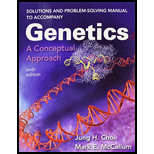
a.
To explain:
The number of chromosomes in individual with allotriploidy including species I and II.
Introduction:
The chromosomal mutations not only involve the change in the structure of chromosome rather it also includes a change in the number of chromosomes. Aneuploidy is the gain or deletion of one ormore individual chromosome. Polyploidy refers to a gain of the whole set of chromosomes. Polyploidy is of two types, namely- autopolyploidy and allopolyploidy.
a.
Explanation of Solution
Allotriploidy arises when a diploid gamete fuses with haploid gamete. There are two possibilities through which allotriploid can form. One possibility is that it inherits
The number of chromosomes in allotriploid individual including species I and species II if it inherits
Another possibility is that it inherits
The number of chromosomes in allotriploid individual if it inherits
b.
To explain:
The number of chromosomes in individual with autotetraploidy in species II.
Introduction:
The chromosomal mutations not only involve the change in the structure of chromosome rather it also includes a change in the number of chromosomes. Aneuploidy is the gain or deletion of one orthe more individual chromosome. Polyploidy refers to a gain of the whole set of chromosomes. Polyploidy is of two types, namely- autopolyploidy and allopolyploidy.
b.
Explanation of Solution
Autotetraploidy results when there occurs four copies of the whole set of chromosomes in individuals. The autotetraploid individual in species II will have a following number of chromosomes.
The number of chromosomes in autotetraploidindividual of species II will be
c.
To explain:
The number of chromosomes in an individual with trisomy in species I.
Introduction:
The chromosomal mutations not only involve the change in the structure of chromosome rather it also includes a change in the number of chromosomes. Aneuploidy is the gain or deletion of one ormore individual chromosome. Polyploidy refers to a gain of the whole set of chromosomes. Polyploidy is of two types, namely- autopolyploidy and allopolyploidy.
c.
Explanation of Solution
Trisomy is the addition of a single chromosome in the whole set of chromosomes. Addition of single chromosome refers to the gain of one extra homologous copy of individual chromosome. Trisomy is represented as
The number of chromosomes in trisomicindividual of species I will be
d.
To explain:
The number of chromosome in individual with monosomy in species II.
Introduction:
The chromosomal mutations not only involve the change in the structure of chromosome rather it also includes change in the number of chromosomes. Aneuploidy is the gain or deletion of one ofmore individual chromosome. Polyploidy refers to gain of whole set of chromosomes. Polyploidy is of two types, namely- autopolyploidy and allopolyploidy.
d.
Explanation of Solution
Monosomy is the loss of one of the copies of the homologous chromosome. It is represented as
The number of chromosome in individual with monosomy in species II will be
e.
To explain:
The number of chromosome in individual with tetrasomy in species I.
Introduction:
The chromosomal mutations not only involve the change in the structure of chromosome rather it also includes change in the number of chromosomes. Aneuploidy is the gain or deletion of one ofmore individual chromosome. Polyploidy refers to gain of whole set of chromosomes. Polyploidy is of two types, namely- autopolyploidy and allopolyploidy.
e.
Explanation of Solution
Tetrasomy is the acquiring of two nonhomologous chromosomes. It is represented as
The number of chromosome in individual with tetrasomy in species I will be
f.
To explain:
The number of chromosome in individual with allotetraploidy including species I and species II.
Introduction:
The chromosomal mutations not only involve the change in the structure of chromosome rather it also includes change in the number of chromosomes. Aneuploidy is the gain or deletion of one ofmore individual chromosome. Polyploidy refers to gain of whole set of chromosomes. Polyploidy is of two types, namely- autopolyploidy and allopolyploidy.
f.
Explanation of Solution
Allotetraploidy arises when a diploid gamete fuses with diploid gamete or a haploid gamete fuses with triploid gamete. The number of chromosomes in allotetraploid if it inherits
There are two possibilities through which allotetraploid can form. The first possibility is that it inherits
The number of chromosomes in allotetraploid individual if it inherits
The second possibility is that it inherits
The number of chromosomes in allotetraploid individual if it inherits
Conclusion:
Autopolyploids are produced because of mistakes which might occur during mitosis or meiosis which results in the production of extra sets of chromosomes. Aneuploidy can be defined as the increase or decrease in the individual chromosome number. Aneuploidy might arise because of the loss of chromosome during mitosis or meiosis or nondisjunction of homologous chromosomes or sister chromatids. There are four types of aneuploidy, namely- nullisomy, monosomy, trisomy, and tetrasomy.
Want to see more full solutions like this?
Chapter 8 Solutions
Solutions and Problem-Solving Manual to Accompany Genetics: A Conceptual Approach
 Human Anatomy & Physiology (11th Edition)BiologyISBN:9780134580999Author:Elaine N. Marieb, Katja N. HoehnPublisher:PEARSON
Human Anatomy & Physiology (11th Edition)BiologyISBN:9780134580999Author:Elaine N. Marieb, Katja N. HoehnPublisher:PEARSON Biology 2eBiologyISBN:9781947172517Author:Matthew Douglas, Jung Choi, Mary Ann ClarkPublisher:OpenStax
Biology 2eBiologyISBN:9781947172517Author:Matthew Douglas, Jung Choi, Mary Ann ClarkPublisher:OpenStax Anatomy & PhysiologyBiologyISBN:9781259398629Author:McKinley, Michael P., O'loughlin, Valerie Dean, Bidle, Theresa StouterPublisher:Mcgraw Hill Education,
Anatomy & PhysiologyBiologyISBN:9781259398629Author:McKinley, Michael P., O'loughlin, Valerie Dean, Bidle, Theresa StouterPublisher:Mcgraw Hill Education, Molecular Biology of the Cell (Sixth Edition)BiologyISBN:9780815344322Author:Bruce Alberts, Alexander D. Johnson, Julian Lewis, David Morgan, Martin Raff, Keith Roberts, Peter WalterPublisher:W. W. Norton & Company
Molecular Biology of the Cell (Sixth Edition)BiologyISBN:9780815344322Author:Bruce Alberts, Alexander D. Johnson, Julian Lewis, David Morgan, Martin Raff, Keith Roberts, Peter WalterPublisher:W. W. Norton & Company Laboratory Manual For Human Anatomy & PhysiologyBiologyISBN:9781260159363Author:Martin, Terry R., Prentice-craver, CynthiaPublisher:McGraw-Hill Publishing Co.
Laboratory Manual For Human Anatomy & PhysiologyBiologyISBN:9781260159363Author:Martin, Terry R., Prentice-craver, CynthiaPublisher:McGraw-Hill Publishing Co. Inquiry Into Life (16th Edition)BiologyISBN:9781260231700Author:Sylvia S. Mader, Michael WindelspechtPublisher:McGraw Hill Education
Inquiry Into Life (16th Edition)BiologyISBN:9781260231700Author:Sylvia S. Mader, Michael WindelspechtPublisher:McGraw Hill Education





